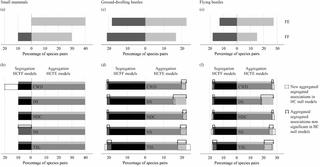PLOS ONE ( IF 2.9 ) Pub Date : 2018-09-20 , DOI: 10.1371/journal.pone.0204445 Hélène Le Borgne 1 , Christian Hébert 2 , Angélique Dupuch 1 , Orphé Bichet 1 , David Pinaud 1 , Daniel Fortin 1

|
Species assemblages can result from deterministic processes, such as niche differentiation and interspecific interactions, and from stochastic processes, such as random colonisation and extinction events. Although changes in animal communities following disturbances have been widely examined, few studies have investigated the mechanisms structuring communities during ecological succession. We assessed the impact of logging on small mammal and beetle assemblages in landscapes dominated by old-growth boreal forests. Our objectives were to 1) characterize variations in communities during the first 66 years of post-harvest forest succession, 2) determine if there are non-random patterns of species co-occurrence (i.e., deterministic processes), and if there are, 3) establish whether non-random co-occurrences are best explained by habitat attributes or by interspecific interactions. We captured small mammals and beetles along a gradient of forest succession (5–66 years) and in old-growth forest, and characterized key vegetation attributes. First, we tested whether community compositions in clear-cut stands became similar to those in natural stands after 66 years. We then used null models, which were either unconstrained or constrained by habitat attributes, to address the last two objectives and distinguish effects of vegetation attributes from interspecific interactions on community assembly. We showed that beetle assemblages differed in stands 21–30 years post-harvest compared to old-growth forests. In contrast, harvesting did not influence the composition of small mammal communities. Overall, our results suggest that community assembly during forest succession is driven by both stochastic and deterministic processes, the latter being linked to interspecific interactions more strongly than to vegetation attributes.
中文翻译:

北方森林采伐后演替过程中动物群落集结的时间动态
物种组合可能来自确定性过程,例如生态位分化和种间相互作用,也可能来自随机过程,例如随机定殖和灭绝事件。尽管已经广泛研究了干扰后动物群落的变化,但很少有研究调查生态演替过程中群落结构的机制。我们评估了在以古老的北方森林为主的景观中伐木对小型哺乳动物和甲虫组合的影响。我们的目标是 1) 描述采伐后森林演替的前 66 年中群落的变化,2) 确定是否存在物种共现的非随机模式(即确定性过程),以及是否存在,3)确定非随机共现是否最好用栖息地属性或种间相互作用来解释。我们沿着森林演替梯度(5-66 年)和古老的森林捕获了小型哺乳动物和甲虫,并描述了关键的植被属性。首先,我们测试了 66 年后,清晰林分中的群落组成是否与自然林分中的群落组成相似。然后,我们使用不受生境属性约束或受生境属性约束的空模型来解决最后两个目标,并将植被属性的影响与种间相互作用对群落组装区分开来。我们发现,与原始森林相比,采收后 21-30 年的林分中的甲虫组合有所不同。相比之下,收获并没有影响小型哺乳动物群落的组成。全面的,










































 京公网安备 11010802027423号
京公网安备 11010802027423号